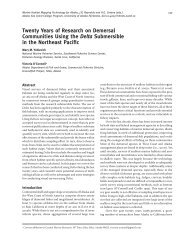724_Final Report.pdf - North Pacific Research Board
724_Final Report.pdf - North Pacific Research Board
724_Final Report.pdf - North Pacific Research Board
You also want an ePaper? Increase the reach of your titles
YUMPU automatically turns print PDFs into web optimized ePapers that Google loves.
Ideally, captive studies should mimic the natural environment as much as possible. Experimental<br />
diets in this study did not mimic the true natural diets of eiders; nonetheless, the experimental diets<br />
demonstrated that tracking diet changes in eiders using FAs is possible. Spectacled and Steller’s eiders are<br />
benthic-feeding birds and do not consume Atlantic krill, silversides or Mazuri in the wild. Spectacled<br />
eiders wintering in the Bering Sea forage on a variety of food items, including clams, mussels, amphipods<br />
and polychaetes (Petersen et al. 1998, Lovvorn et al. 2003). Steller’s eiders have been reported to<br />
consume a diverse diet of invertebrates, suggesting they are non-selective foragers (Petersen 1980,<br />
Petersen 1981, Bustnes and Systad 2001). During the nesting season, eiders feed on insects, insect larvae,<br />
seeds, and plant materials in tundra ponds resulting in a diet higher in carbohydrates (Petersen et al. 2000,<br />
Fredrickson 2001). In our experiment, the simulated pseudo diet 5 consisted of 50% clam and 50%<br />
mussel and was well estimated using the model and FA subsets indicating that two species of bivalves can<br />
be distinguished from each other. However, the simulated pseudo diets and actual diets were comprised of<br />
only five diet items. Thus, further work is needed to examine the FA profiles of clams, amphipod,<br />
polychaetes and other diet items of wild eiders.<br />
For interpretation of the time frame that the estimated diet represents, results from our captive<br />
study to estimate diets of wild eiders should be applied with caution. For example, Day 0 eider biopsies<br />
indicate that if the diet had been constant for 10 weeks, the estimated relative proportion of diet items<br />
using QFASA are very accurate. However, without knowing that the diet had been constant for 10 weeks,<br />
a dietary percentage of 20% could mean that (1) the diet item was truly 20% of a constant diet, (2) the<br />
proportion of that diet item was much greater (perhaps 50%) up until 3-4 weeks prior to biopsy sampling<br />
and had not been consumed at all after that, or (3) the proportion of that diet item increased over the last<br />
3-4 weeks but was not consumed before then. Thus, the exact quantitative proportions in diet do indeed<br />
represent a perhaps unknown integrated period and may be less meaningful than detecting shifts in diet.<br />
That is, sampling birds at arrival on breeding grounds over time can detect shifts in diets at staging areas<br />
24



